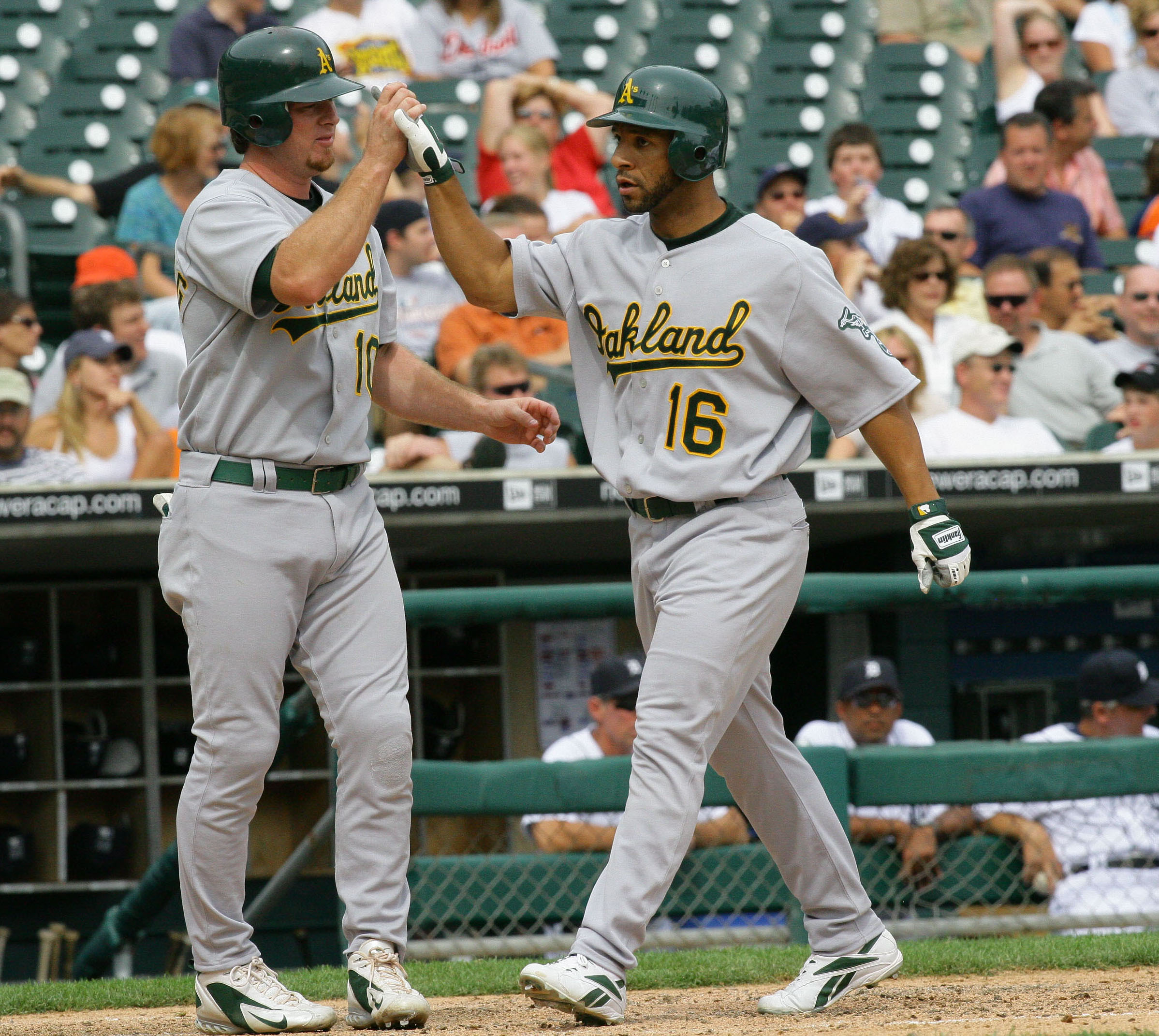
Scott Hatteberg: Where is the ‘Moneyball’ picking machine now?
OAKLAND, Calif. (BVM) – Former MLB player Scott Hatteberg likely didn’t expect a resurgence in popularity following his playing days. Though he played 14 years in the majors with the Boston Red Sox, Oakland Athletics and Cincinnati Reds, his spot in history was relegated more to a bit player who had his moments though never anything spectacular like a World Series Championship or major award. Instead, Hatteberg was featured in a 2003 book, ‘Moneyball’ by Michael Lewis where the author described the 2002 Oakland A’s and their against-the-grain front office strategy of targeting players.
However, when this movie got turned into a blockbuster feature film starring Brad Pitt, Hatteberg would be thrust back into the spotlight thanks to a standout performance by Chris Pratt who played the former athlete. Now, Hatteberg is recognized by baseball fans young and old thanks to the movie and remains a recognizable face in Oakland and with the A’s, whom he still works for today.
Early years and college career
Hatteberg grew up in Yakima, Washington in the 1970s and 80s where he played for his local American Legion team, the Beetles, during his younger years before going to Eisenhower High School in the city. Hatteberg would become an all-state member for the Cadets his senior season. This would garner the attention of in-state Washington State University, where Hatteberg would commit.
During his three–year career with the Cougars from 1989-1991, Hatteberg would quickly become one of the best players for WSU. As the team’s primary catcher, Hatteberg led the Cougars with a .381 batting average, 88 hits, 145 total bases, a .628 slugging percentage and tied a then-conference record with 29 doubles. He earned first-team All-Pac-10 North honors and was the Region VII Selection Hitter award recipient that season. Following his stellar sophomore performance, Hatteberg was selected for Team USA and toured Europe with a Pac-10 All-Star team, where he hit a team-best .467.
The next season was much of the same for Hatteberg. As a junior, Hatteberg hit .365 with 21 doubles, tied for fifth on WSU’s single-season list, and captured Pac-10 North MVP honors, first-team All-Pac-10 accolades for the second-straight season, and was named to the ABCA All-District second team. He would be inducted into the school’s athletics Hall of Fame in 2015.
Boston Red Sox days
With high expectations of his abilities at the professional level, the Boston Red Sox selected Hatteberg with the No. 41 overall pick in the first round of the 1992 MLB Draft. This is where Hatteberg would spend most of his 14-year career, playing seven seasons for Boston.
Hatteberg would be called up to the Majors in 1995 and would play 454 games for the Red Sox, batting .267 with an on-base percentage of .357 with 159 RBIs, 86 doubles and 34 home runs.
Unfortunately for Hatteberg, his time in Boston would come to a tragic end. In May 1999, Hatteberg ruptured his ulnar nerve in his throwing arm forcing him to have surgery to repair the damage. This would cause issues as Hatteberg would struggle to relearn how to grip and throw the ball again. After a couple more partial seasons with Boston in 2000 and 2001, he would be dealt to Colorado where they would release him.
Moneyball era
Prior to the 2002 MLB season, it seemed as though time was up for the 31-year–old catcher. With a lack of ability to throw the ball consistently from behind the plate, it would be hard for him to find his footing in the majors again. Enter the Oakland A’s.
The A’s general manager at the time, Billy Beane, was testing a new kind of cost-saving scheme that would allow his team to compete with the bigger payrolls of opposing franchises. Coined as “moneyball” the theory would be to accumulate cheaper talent who have a propensity for efficiency such as getting on base or getting outs despite their outward statistics. Hatteberg was the perfect fit given his consistently high on-base percentage and lack of attention due to his bad arm. The A’s would sign the catcher not to play behind the plate, but to play first base.

Though the transition would be difficult for the vet, he would slowly come into his own as a reliable enough first baseman. During the 2002 season, the A’s would break an American League record by winning 20-straight games. If it wasn’t for Hatteberg, it may never have happened.
In the Oakland Coliseum on Sept. 4, 2002, the A’s were one win away from history. The team scored 11 runs in the first three innings and seemed destined to win the historic game. But then they began fumbling away the game as the Kansas City Royals went on to score 11 unanswered with the A’s up to bat in the bottom of the ninth.
With one out, Hatteberg was subbed to pinch-hit. After taking a first-pitch ball, Hatteberg would deposit the next pitch over the right-centerfield wall to win the game in a walk-off, sending the sold–out crowd into a frenzy. This would be the highlight of Hatteberg’s time with Oakland and his career.
Hatteberg would play four seasons in Oakland, helping the A’s make back-to-back playoff appearances in 2002 and 2003. He finished his time in Oakland playing 569 games with 263 RBIs, 105 doubles and 49 home runs with a batting average of .269 and an on-base percentage of .355.
Reds and retirement
The veteran would sign with the Cincinnati Reds in the 2006 offseason, ending his tenure with the A’s. Over the next three seasons, Hatteberg would play first base for Cincinnati before he was replaced by team legend Joey Votto. During his time with the Reds, Hatteberg would record his 1,000th career hit on August 8, 2006 against the St. Louis Cardinals. He would be released in June 2008 after three seasons where he played 291 games with 105 RBIs, 58 doubles and 23 home runs with a batting average of .291 and an on-base percentage of .384.
Hatteberg subsequently retired, ending his 14-year career. He finished his time in the majors with 1,153 hits, 527 RBIs, 249 doubles and 106 home runs while batting .273 with an OBP of .357.

Moneyball movie and continued relationship with A’s
In 2011, the movie “Moneyball” adapted from Lewis’ novel would hit theaters and become a hit. The film earned six Oscar nominations including ones for Best Motion Picture of the Year and Best Adapted Screenplay. The film, which featured Hatteberg’s arrival to Oakland as a struggling first base experiment to his highlight home run, would bring the former Athletic back into the public eye and cement his legacy as an Oakland legend.
It was around that same time that Hatteberg would take on his second career–MLB Scout. Using his connections with the A’s, Hatteberg was hired by the team in 2011 and he hasn’t looked back since. According to the former athlete’s LinkedIn profile, he continues to work for the A’s as a special assistant to baseball operations. Though he did work a couple of years as a color commentator for NBC’s A’s broadcasts from 2013-2014, it appears that Hatteberg has found his happy place working for the team that helped him continue his career.
Today, Hatteberg remains in his home state of Washington where he lives with his wife Elizabeth and their three daughters Lauren, Sophia and Ella. While Hatteberg may not have expected to ever be recognized as a baseball star when he retired in 2008, his legacy will live on forever in Oakland and on film.






